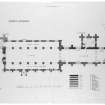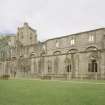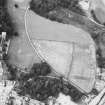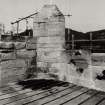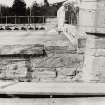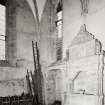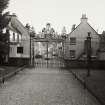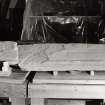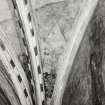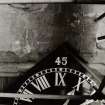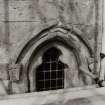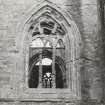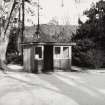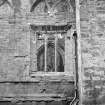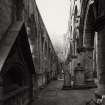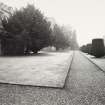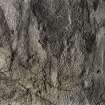Dunkeld, Cathedral Street, Dunkeld Cathedral
Burial Ground (Medieval), Cathedral (Medieval), Cross Slab(S) (Early Medieval), Grave Slab (Medieval)
Site Name Dunkeld, Cathedral Street, Dunkeld Cathedral
Classification Burial Ground (Medieval), Cathedral (Medieval), Cross Slab(S) (Early Medieval), Grave Slab (Medieval)
Alternative Name(s) Dunkeld Parish Church
Canmore ID 27156
Site Number NO04SW 1
NGR NO 02393 42595
Datum OSGB36 - NGR
Permalink http://canmore.org.uk/site/27156
First 100 images shown. See the Collections panel (below) for a link to all digital images.
- Council Perth And Kinross
- Parish Dunkeld And Dowally
- Former Region Tayside
- Former District Perth And Kinross
- Former County Perthshire
NO04SW 1.00 02393 42595
(NO 0237 4259) Cathedral (NR)
(Partly in ruins) Church (NAT)
Site of Monastery (NR)
Tower (NR)
Standing Stone (NR) (Sculptured).
OS 25", Perthshire, (1901).
NO04SW 1.01 NO 0237 4259 Roman Coins; Medieval Coins
NO04SW 1.02 NO 0237 4259 Pictish Symbol Stone
NO04SW 1.03 NO 0237 4259 Cross-slab
NO04SW 1.04 NO 0237 4259 Cross-slab
NO04SW 1.05 NO 0237 4259 'Hogback Stone'; Grave-slab
NO04SW 1.06 NO 0237 4259 Incised Slab
NO04SW 1.07 NO 0239 4258 Chapel; Tomb
NO04SW 1.08 NO 0237 4259 Tomb
NO04SW 1.09 NO 0239 4258 Tomb
NO04SW 1.10 NO 0237 4259 Cross-slab
NO04SW 1.11 NO 02463 42597 Gates
NO04SW 1.12 NO 02393 42596 Monument to the 1st Marquess of Atholl
NO04SW 1.13 NO 02393 42596 Black Watch Monument
For Dunkeld, Bishop's Palace (NO c. 022 426), see NO04SW 15.
Dunkeld Cathedral, founded before 1337 (D E Easson 1957) on site of the Dark Age See of Alba before removal to St Andrews. (Information from C W Phillips, DA Index)
M E Root 1962
The choir has been restored and is in use as the parish church.
The cathedral possesses several sculptured stones, one which was used as a gatepost at the entrance to the churchyard, and now stands on the S side of the church close to it. Another, which was used as a tombstone of a farmer in 1729, afterwards formed part of the pavement floor of the cathedral. This latter part of a cross-shaft depicts a horse standing on its hind legs. It is illustrated by Stuart.
J Stuart 1856; J R Allen and J Anderson 1903.
Two class I and one class II [Pictish] symbol stones.
A Mack 1997.
NO 023 425 A programme of archaeological monitoring was undertaken at Dunkeld Cathedral during shallow excavations along the line of an existing footpath. A cobbled surface was exposed at a depth of 280mm, appearing to represent a cobbled entrance way into the cathedral courtyard.
Sponsor: Historic Scotland
D Stewart 2000.
Cathedral (remains of) [NAT] (at NO 02370 42595)
Church [NAT] (at NO 02415 42593)
OS (GIS) MasterMap, April 2010.
Architect: J.G.Lough memorial to Major General Sir Robt. Henry Dick 1847
Sir John Steel memorial to 42nd Black Watch 1871
Dunn & Watson reroofed & refurnished Parish Church 1908
Ternouth, London monument to Lord Charles Murray
urn on plaque in Atholl mausoleum c.1824
pedestrian monument to 4th Duke of Atholl 1834
Patrick Murray monument to Atholl family in mausoleum. Designed by Alexander Edwards 1704. Finished 5.1.1713.
Choir of Cathedral now the Parish Church.
NMRS REFERENCE
Inglis Photograph Collection
'215 Dunkeld Cathedral' print 1930s or 40s Acc No 1994/90
Photographic Survey (1900 - 1930)
Photographs by A Brown & Co of sites across Scotland c1900-1930
Photographic Survey (1955)
Photographs of buildings in Dunkeld, Perthshire, by the Scottish National Buildings Record in 1955.
Field Visit (17 April 1975)
Dunkeld Cathedral is partly under the care of the D o E and is open to the public. The nave is roofless but otherwise in good order, and the choir is now used as the parish church and is in the care of the Church of Scotland. It has no name, being part of the Cathedral, but is locally called the Cathedral Church.
The sculptured stone formerly outside the S wall is now preserved inside the choir in the SE corner.
Another sculptured stone depicting a horseman, and a hog-backed stone, are in the tower, but there is no trace of the one used as a tombstone in 1729.
Visited by OS (AA) 17 April 1975
Photographic Survey (1987)
Recording of gravestones in the burial ground of Dunkeld Cathedral by Mrs Betty Willsher in 1987.
Field Visit (9 February 1990)
Dunkeld has been an ecclesiastical centre since at least 848-9. At that time, Boethius' Scottish Chronicle records that Kenneth MacAlpin 'brought relics of Saint Columba to a church that he built', and, although the name of the church is not given, it is thought to have been at Dunkeld. Apparently, Kenneth intended that Dunkeld should be the primary centre of the church in eastern Scotland, although structural evidence for this early ecclesiastical centre is lacking. Nevertheless, two stones bearing Pictish carvings (NO04SW 1.04 and 1.09) and a large cross-slab (NO04SW 1.03) have been discovered here, and another stone bearing an incised horseman, now at the cathedral, comes from nearby (NO04SW 1.02).
Although the ecclesiastical primacy of Dunkeld was subsequently transferred to St Andrews (by 943), some form of church community survived until the revival of the see by Alexander I (1107-24). Work on the present cathedral was not begun until the thirteenth century; the choir was completed in the fourteenth century and work extended to the nave in the fifteenth century. Between 1450 and 1475, the west tower, the south porch and the chapter-house were all added. The see was declared void in 1571 and the roof was removed from the church, but in 1691 the choir was renovated for use as the parish church.
Notable monuments within the cathedral include: a coped medieval graveslab (NO04SW 1.05); an effigy of Bishop William Sinclair (14th century); the tomb-chart and effigy believed to be of the Wolf of Badenoch (died 1406) (NO04SW 1.08); and the tomb of Bishop Cardeny (died 1436) (NO04SW 1.09).
Visited by RCAHMS (IMS) 9 February 1990.
M E Root 1950; I B Cowan and D E Easson 1976.
Excavation (August 1993)
NO 024 426 A one-day watching brief was completed on the site
during the clearance of a shallow foundation trench for an extension
of the existing public toilets. A fragment of truncated walling was
revealed, probably associated with extensive post-medieval
occupation towards the E of cathedral precinct.
G Ewart 1993
Sponsor: Historic Scotland
Kirkdale Archaeology
Watching Brief (14 February 2000)
NO 023 425 A programme of archaeological monitoring was undertaken at Dunkeld Cathedral during shallow excavations along the line of an existing footpath. A cobbled surface was exposed at a depth of 280mm, appearing to represent a cobbled entrance way into the cathedral courtyard.
Sponsor: Historic Scotland
D Stewart 2000
Kirkdale Archaeology
Watching Brief (16 December 2003)
Under the terms of its call-off contract with Historic Scotland, Kirkdale Archaeology was asked to undertake a watching brief at Dunkeld Cathedral. Historic Scotland MCU personnel and volunteers from ‘The Friends of Dunkeld Cathedral’ undertook the excavation of a cable trench in order to supply electricity to the existing floodlights as the original cable was damaged beyond repair. The cable path was sited on the N side of the cathedral at its E end, ‘dog legging’ around the NE corner, terminating on the E side near the appropriate floodlight.
The lack of any significant archaeological remains was somewhat unexpected. The Friends of Dunkeld volunteers noted that during the 19th century the Duke of Atholl had re-landscaped the area surrounding the cathedral. In doing so the ground level was reduced by 500-700mm (patches of ground observed may indicate the original ground level) and the human remains encountered were deposited on the bank of the river and the associated headstones re-erected within the nave of the cathedral.
G Ewart 2003
Sponsor: Historic Scotland
Kirkdale Archaeolgoy
Observation (June 2009 - July 2009)
NO 02393 42595 This small collection, which was assessed during June–July 2009, has recently undergone conservation and has been set up in a new display in the W tower of the cathedral. Among the earlier pieces there is a hog-back tomb, the upper face of which has a cross with a stepped calvary on one side and clear tegulation on the other. A later piece is the tomb of Alexander Douglas (d 1547), where the slab is incised with the figure of a churchman, his hands clasped in prayer, wearing a fringed stole, chasuble and alb. A cross with a stepped calvary is incised to the right of the figure. Near the damaged lower edge, and therefore incomplete, is a shield with two stars above seven pheons(?) with a chalice above. This and other inventories of carved stones at Historic
Scotland’s properties in care are held by Historic Scotland’s Collections Unit. For further information please contact hs.collections@scotland.gsi.gov.uk
Funder: Historic Scotland
Project (25 October 2012 - 9 November 2012)
NO 02393 42595 Geophysical surveys were undertaken, 25 October – 9 November 2012, in the grounds of Dunkeld Cathedral as part of a pilot research project investigating early medieval monasteries in Perth and Kinross. The cathedral grounds were surveyed with resistance and gradiometer, and a total station survey was also completed. High resistance readings indicative of building remains were recorded SW and SE of the Cathedral. The W group were a series of linear readings interpreted as remains of the late medieval Bishop’s Palace and Chanonry. East of this a prominent area of disturbance correlates with the site of St Adamnan’s Cottage; a demolished 19th-century mansion and designed landscape. Curvilinear anomalies indicated potential early medieval monastic remains in a level area at the SW of the grounds. Local volunteers assisted with the survey.
Archive: RCAHMS and PKHT
Funder: Society of Antiquaries of Scotland
Oliver JT O’Grady, OJT Heritage
2012
Magnetometry (25 October 2012 - 9 November 2012)
NO 02393 42595 Gradiometer survey
Archive: RCAHMS and PKHT
Funder: Society of Antiquaries of Scotland
Oliver JT O’Grady, OJT Heritage
2012
Earth Resistance Survey (25 October 2012 - 9 November 2012)
NO 02393 42595 Resistance survey.
Archive: RCAHMS and PKHT
Funder: Society of Antiquaries of Scotland
Oliver JT O’Grady, OJT Heritage
2012
Project (25 October 2012 - 9 November 2012)
NO 02393 42595 Geophysical surveys were undertaken, 25 October – 9 November 2012, in the grounds of Dunkeld Cathedral as part of a pilot research project investigating early medieval monasteries in Perth and Kinross. The cathedral grounds were surveyed with resistance and gradiometer, and a total station survey was also completed. High resistance readings indicative of building remains were recorded SW and SE of the Cathedral. The W group were a series of linear readings interpreted as remains of the late medieval Bishop’s Palace and Chanonry. East of this a prominent area of disturbance correlates with the site of St Adamnan’s Cottage; a demolished 19th-century mansion and designed landscape. Curvilinear anomalies indicated potential early medieval monastic remains in a level area at the SW of the grounds. Local volunteers assisted with the survey.
Archive: RCAHMS and PKHT
Funder: Society of Antiquaries of Scotland
Oliver JT O’Grady, OJT Heritage
2012
Watching Brief (11 March 2016 - 21 March 2016)
NO 02328 42600 (NO04SW 1) A watching brief was undertaken, 11–21 March 2016, during the planting of 15 trees and installation of an information board at the scheduled monument of Dunkeld Cathedral. The work was carried out in a forested area, crossed by several paths, to the W of the cathedral building. In five pits, concentrations of stone fragments probably relating to landscaping during 19th-century tree planting were recorded.
Archive: NRHE (intended)
Funder: Perth and Kinross Countryside Trust
Chris Fyles – Alder Archaeology Ltd
(Source: DES, Volume 18)
Note (August 2017)
An Urban Battle and a Cathedral Under Fire
We have arrived at August and the 'Age of Clans and Clearances' is upon us, so why do we find ourselves at a semi-ruinous medieval Cathedral? Nestled among the hills on the banks of the River Tay, this would have been a beautiful spot even before the creation of the designed landscape of which the cathedral is now part. Yet Dunkeld Cathedral was the site of a pivotal battle between Cameronian Regiment (the 26th Foot) and the Jacobite clans. This was an urban battle and that was perhaps key to the Cameronian regiment's success.
Dunkeld was an incredibly important triumph for the Government forces. It occurred just a month after the Jacobites' decisive victory at Killecrankie on 27th July 1689. Had the Jacobites won at Dunkeld, the road to Perth would have been open to them, with Stirling beyond. This close-quartered and violent battle turned the tide in favour of King William, but it scarred the town, much of which was burned to the ground.
There are few indications at the site today of what took place here on 21st August 1689 - save the shot holes in the east gable of the cathedral and the initials 'I.G.' together with the date '1689' mysteriously carved into a reused grave marker. This is now displayed in the west tower. Lieutenant Colonel William Cleland, commander of the Covenanter regiment, is buried in the nave, while he and his regiment are also commemorated at the site.
We do have some idea of how the cathedral precinct and the town looked at around this time. Slezer's Prospect of the Town of Dunkeld, produced just a few years after the battle, shows the south side of the cathedral and buildings which are no longer extant, including the remains of the Bishop's Palace. The houses which occupy the site on either side of the High Street recall The Vicar's Close at Wells: tight rows of buildings, the plan of which is preserved to the present day; while Dunkeld House, demolished in the 1800s, stood to the north of the cathedral. Much of the town was destroyed during the battle, which was located around the north of the cathedral . Thereafter, a new town was built to the east, conveniently opening up the view from Dunkeld House to the cathedral and the river. Fortunately, the cathedral building itself appears to have fared rather better and looks much the same now as it does in Slezer's engraving.
The potential for the survival of archaeological evidence of the battle is high. The old town site has been surveyed by The University of Glasgow and traces of it have been located, while those who died during the fighting are probably buried near the cathedral.
'These wretches in the fire'
On 17th August 1689, the Cameronian Regiment under Cleland arrived in Dunkeld, newly formed and without battle experience. Cleland himself was a veteran of Drumclog and Bothwell Bridge, but his regiment had been formed only four months before. The men were enlisted from the United Societies, who had become known as 'Cameronians', after the Reverend Richard Cameron, a militant Covenanter, who had been killed at the battle of Airds Moss in 1680. They were expected to hold the town at all costs, a daunting task, as thousands of Jacobites were heading south from Killiecrankie. The latter had lost their commander, John Graham of Claverhouse, (known to history as 'Bonnie Dundee'), but had nevertheless won the battle. Their new leader, Colonel Cannon, with far superior numbers, had every reason to be confident, although his military skills did not match those of his predecessor.
Dunkeld, for all its beauty, is not obviously defensible. It sits in a dip between hills from which it is readily overlooked and the town had no walls. Nevertheless, Cleland ordered his men to fortify the cathedral precinct and Dunkeld House.
The battle began at seven o'clock on the morning of 21 August. The Jacobites attacked the town from all sides. Cleland was mortally wounded within the hour and command passed to Major James Henderson, who was killed almost immediately. Captain George Munro then took overall command, while his position at the Cross was taken by Lt. Henry Stewart of Livingstoune, who was killed when this position was rushed. The Cameronians were forced back to the cathedral, Dunkeld House and three houses. Pikemen and halberdiers were attacked by Jacobite swords, but their method of fighting was not effective in an urban setting and the bodies of fallen soldiers hindered their advance. Cameronian musketeers entered the houses and fired on them. The buildings were set alight by both sides - the Cameronians to kill the Jacobites hiding within and the Jacobites to push back their assailants. Thick smoke engulfed the town but as the Cameronians were pushed back to the point where they would be forced to make a last stand, the Jacobites retreated. Whether this was due to exhaustion, fear of reinforcements, or terror of their opponents is not clear.
Today many of the houses in Dunkeld are cared for by The National Trust for Scotland. The eastern part of the former cathedral is roofed and remains an active church, while the western nave and tower are cared for by Historic Environment Scotland. Much of the description above is taken from Historic Environment Scotland's Battlefield Inventory, but there has been no rigorous modern assessment of the battle in recent times. However, it is documented in primary and secondary sources; while also being recalled in poetry, song and oral history.
Kirsty Owen - Senior Archaeology Manager













































































































